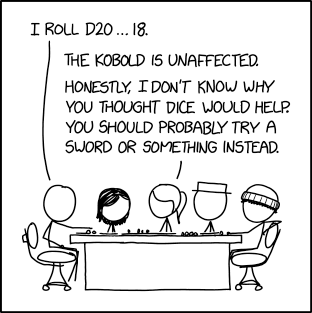D Roll

Under some circumstances, if you throw a D8 and then a D12 at an enemy, thanks to the D8's greater pointiness you actually have to roll a D12 and D8 respectively to determine damage.

Under some circumstances, if you throw a D8 and then a D12 at an enemy, thanks to the D8's greater pointiness you actually have to roll a D12 and D8 respectively to determine damage.
This comic is a scene from a tabletop roleplaying game, probably Dungeons & Dragons. In 3015: D&D Combinatorics, the same people, Cueball, Megan, Ponytail, White Hat and Knit Cap, are seated playing D&D in the same seats, where Cueball seems to represent Randall.
Here Cueball announces "I roll D20... 18," referring to rolling a 20-sided die and getting the relatively high score of 18, presumably while in a fight with a kobold (a small reptilian humanoid creature in D&D.) The Dungeon Master (DM, or game master), Ponytail, responds that the kobold is unaffected, but suggests using a sword instead, pointing out the absurdity of trying to defeat an enemy by rolling dice at them. (Ponytail was also the dungeon master in the previous D&D comic).
Cueball made the mistake of assuming that Ponytail would understand which of his weapons or other melee attacks he intended to use, but she had no way of knowing that, so she decided to gently tease him about the omission. This is a common mistake, and being gently made fun of is a common result. The player will usually be allowed to state the specific attack intended and roll again.[actual citation needed] It could also have to do with the idea that some people forget D&D is a roleplaying game and just roll dice without explaining, for example, how they charm the shopkeeper.
However, the possibility exists that the players' characters have actual dice, such as those which were role-played as being produced in 244: Tabletop Roleplaying. The title text suggests that if you literally threw dice as weapons, an eight-sided die (D8) would do more damage than a twelve-sided die (D12) because of its pointier shape, so ironically, you might need to roll the D12 to determine the D8's damage and vice versa, in "some circumstances." As per the Background below, those circumstances are considerably slight. The effectiveness of the d65536 in this context has yet to be determined.
Background
When attacking an enemy in D&D, regardless of the weapon used, the attack starts with a d20 roll to see if it lands a solid hit. If a sufficiently high (or in the earliest editions, sufficiently low) number is rolled, the attack hits, and then further dice (chosen depending on the weapon's form and any magic it might possess) are rolled to determine damage. Before any dice can be rolled at all, however, the player must declare which enemy they are attacking and what with. This is trivial if the attacking character always uses the same weapon and is facing a single enemy, but becomes an important question if the fight is more complex. Consider a case where there are two kobolds present, one wearing plate armor while the other has only a loincloth on (the armor requiring a better d20 roll to defeat), and the player carries both a greatsword (dealing heavy general damage) and the magical "Icepick of Instant Kobold Death" (normally ignored but in this case very useful) and also has magic item that can shoot a destructive Scorching Ray. There are also certain weapons that deal subpar damage on a typical attack, but trigger a powerful extra effect on a very good roll such as 18, making it even more important to specify which weapon one is using before making the roll. A cheating player might roll first, and then decide which weapon they were using and on which target. This could also be used to avoid wasting a weapon (or particular ammunition) with limited uses.
By D&D 5 rules, a stone hurled from a sling does 1d4 bludgeoning damage. A sling bullet typically weighs 3/40 pound (1.2 oz, 35 g), a plausible weight for a normal-sized die made of a moderately dense material. Presumably, an object of similar weight that's thrown "by hand" rather than with a sling would do less damage, though a heavier object might do similar damage (albeit with less range). The D&D 3.5 spell Magic Stone enhances ordinary small stones so they do 1d6+1 damage when hurled, or 2d6+2 when striking undead creatures. So depending on the setup, a D&D character throwing a die at an enemy could theoretically cause considerable harm, but would normally be much better served with an intentionally crafted weapon.
Alternately, DMs may take umbrage at a player's presumption to roll dice for actions before being asked to, and this could be interpreted as a chiding. Sometimes rolls are not necessary in cases where success is automatic (the kobold is effectively helpless) or impossible (the kobold is magically immune to physical attacks), although it should be the DM's own choice whether to still test for a meaningful critical failure or success, despite it being an apparently foregone conclusion of either kind. There are also other circumstances where the required dice is(/are) different in this instance from that which the player may assume. From a practical perspective, if the performed rolling of the dice is not required (or correctly composed) for the DM's purposes, they can choose to ignore it and/or ask for some other roll(s) to be made. It may then be the player that might be most upset by having rolled a 'good' roll that has been 'wasted', on the principle that they would have liked it to have it happen later, when it actually mattered, despite this being statistically irrelevant, assuming that the DM doesn't keep any such details mysteriously hidden.